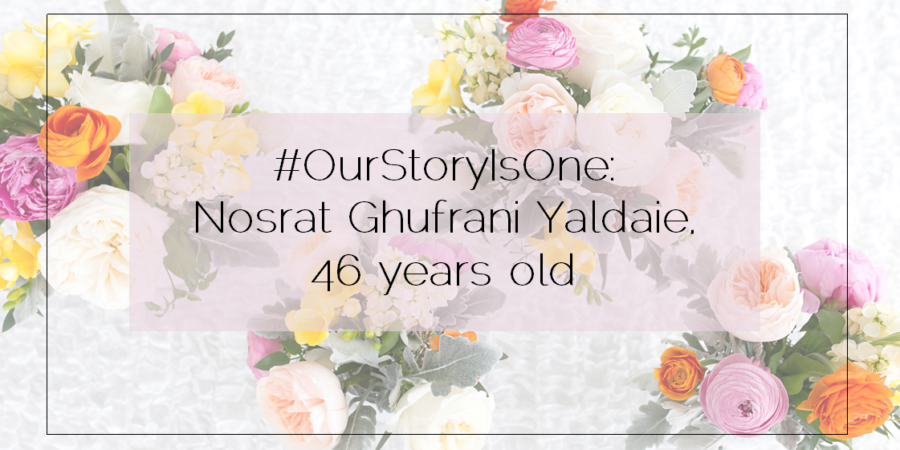I thought it would get easier, writing about the two older women in the group of ten that I think of as “The Shiraz Ten”. But guess what? It isn’t. Because 46 and 57, the ages of the last two women left to cover, is not old; they both had a lot of life left, and a lot of good to do.
I didn’t find much about Nosrat Ghufrani Yaldaie. She completed her elementary school education, but I didn’t find anything about high school or university. She was a wife, a mother, and a homemaker. She was also active when it came to building community and serving others. I can’t help but wonder if this is a reflection of her own humility, of her just living her life without making many waves, quietly and systematically contributing to making her corner of the world better. Because as you will read, this woman had incredible strength.
Nosrat was arrested on the now, at this point in my #OurStoryIsOne project, infamous date of 23 October 1982. Guards entered her home about ten minutes after members of a Bahá’í committee, to which her son belonged, had left the premises.
The guards searched the Yaldaie home, confiscating Bahá’í and other books and documents. Then, she, her son, her husband, and their Bahá’í neighbors were arrested and taken to Sepah Detention Centre. There, she was subjected to humiliating treatments. Because she was a Bahá’í, she was considered “unclean, and prison authorities refused to have any physical contact with her. The guards believed this so thoroughly that when they were guiding blindfolded Bahá’í prisoners to and from interrogation rooms, they would give Nosrat and other Bahá’ís the end of a folded newspaper and hold the other end, to avoid touching them.
Her initial interrogation at Sepah was held on 25 October 1982. She was asked about the names of other members of the Local Assembly of Shiraz, of which she was also a member. After refusing to give names and addresses of her fellow Bahá’ís, she was taken to the prison basement by a female guard, who removed some of her clothes, tied her to a bed facing down, and instructed a guard to flog her while the female guard verbally abused her, and the interrogator stood next to the bed holding on to her file. During that episode, she received 50 lashes on her back and 50 on her feet. She was repeatedly asked to denounce her faith publicly and urge other Bahá’ís to return to Islam. She refused and was beaten, given as many as 200 lashes twice. According to reports by former cellmates, weeks after she was subjected to such treatment, sore spots and open wounds were still visible on Nosrat’s body. Nosrat was also subjected to psychological abuse by various methods including sleep deprivation and solitary confinement for 55 days with very limited personal hygiene privileges.
On 15 January 1983, Nosrat was transferred to Adelabad Prison. Iranian authorities provided no detail regarding her trial to her family. Authorities informed Nosrat that she would be subjected to four “sessions” during which she would be given the opportunity to recant her faith and accept Islam. She was informed that if she did not sign a prepared statement rejecting the Bahá’í faith, she would be killed. It is unclear if all these sessions took place and whether or not these sessions replaced a trial. Maybe the authorities realised that someone who had accepted all the torture that Nosrat had would certainly not yield to such sessions?
Ultimately, of course, the Revolutionary Court of Shiraz sentenced Nusrat Yalda’i to death and the Supreme Court approved the sentence. On 18 June 1983, she was taken, along with the other nine women, to Chogan Square, where she was forced to watch as the other women were hanged. When her turn came, she was given a final chance to recant her faith. When she refused to do so, she was hanged, two days after her son, Bahram Yaldaie, had also been executed in the same way.
The authorities did not inform Nosrat family of her execution. Her family learned of the execution accidentally and was not allowed to bury her body. The authorities buried her along with the other executed Bahá’ís in the Bahá’í cemetery of Shiraz, without washing her or observing any other burial custom.
Never be fooled by a quiet person, one who “only” is a homemaker; they really are such a vital part of our society, and incredible potential contributors to the well-being of their entire community. I can guess that Nosrat was a cornerstone of her family and of her community, quietly doing what needed to be done despite whatever hardships came her way, solely on the strength of her character and her faith. What an amazing world we’d live in if everyone did the same!
Find my entire #OurStoryisOne project here. For more information, visit the official #OurStoryisOne website, here, or follow on Instagram.

